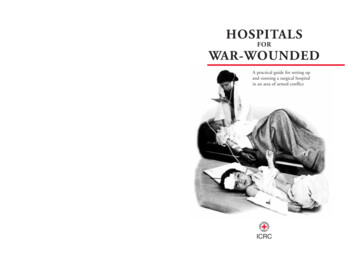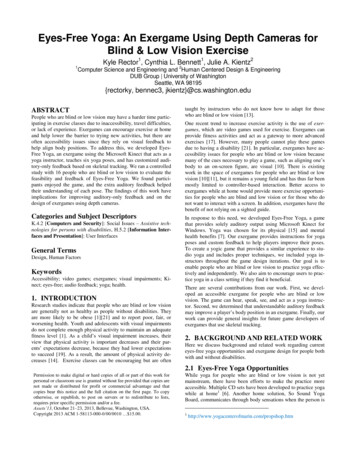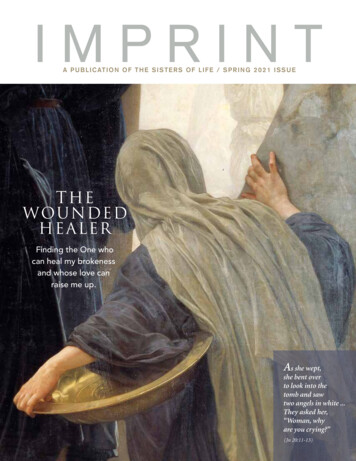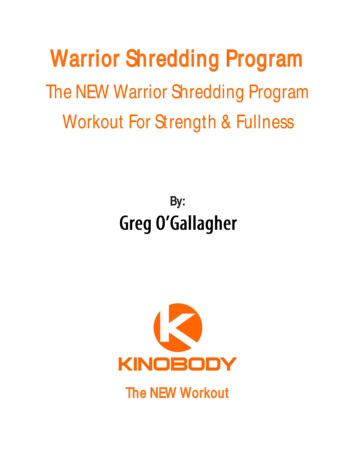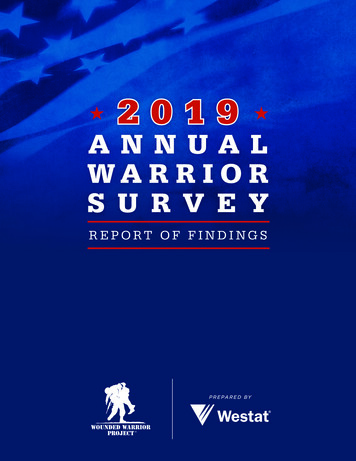
Transcription
2019ANNUALWAR R IORS U R V E YREPORT OF FINDINGSP R E PA R E D BY
EXECUTIVE SUMMARYThis executive summary includes a brief description of the survey purpose, content, andadministration as well as top-line findings from the collected data. More detailed information canbe found in the body of the report.ABOUT THE SURVEYSURVEY OBJECTIVE. The 2019 Wounded Warrior Project (WWP) Annual Warrior Survey wasthe 10th annual administration of the survey. The first survey, in 2010, collected baseline dataon WWP warriors. The subsequent surveys provide updates and allow WWP to identify trendsamong its warriors and to compare their outcomes with those of other military and veteranpopulations. The survey is NOT intended to measure the impact of individual WWP programs.WWP uses the annual survey data to determine how it can better serve its warriors.SURVEY CONTENT. The survey measures a series of outcome domains within the followinggeneral topics about WWP warriors: Background Information (military experiences anddemographic data), Physical and Mental Well-Being, and Financial Wellness.2019 SURVEY ADMINISTRATION. The web survey was fielded to 109,968 WWP warriors fromMarch 26 to May 22, 2019, and 35,908 warriors completed the survey. Email communicationsincluded a prenotification, survey invitation, and nine reminders. Warriors who completed thesurvey were offered a WWP Warrior Tactical Patch as a small token of appreciation for theirparticipation.The final unweighted response rate for the 2019 survey was 32.7 percent (35,908 completedsurveys among 109,968 eligible warriors), which was one percentage point lower than lastyear’s 33.7 percent response rate. After data collection, the survey data were weighted to allowthe production of estimates that are representative of the 2019 WWP population.ACKNOWLEDGMENTSThe 2019 Annual Warrior Survey Report was prepared by Westat on behalf of Wounded WarriorProject. Contributing authors to this report were Michael Hornbostel, April Fales, ChristineBorger, Kaitlynn Genoversa-Wong, Chinedum Orji, Wayne Hintze, Rebecca Noftsinger, WilliamCecere, Randy Herbison, and Jo Chung. The front and back covers of the report were providedby WWP. We would like to recognize Joel Bartholomew, Amanda Peterson, and ElizabethOdom at WWP for their guidance and feedback during production of this report. Mostimportantly, a special thanks to all the warriors and caregivers who took the time to providevaluable feedback that makes this report possible. We also thank them for their contributions toour country.2019 Wounded Warrior Project Survey Resultsi
TOP-LINE FINDINGSWARRIOR BACKGROUND INFORMATIONDEMOGRAPHIC PROFILE. The following presents a 2019 demographic profile of WWP warriors.(All estimates are based on weighted data.) Men – 82.7% Mean age – 42 years Currently married – 65.9% Bachelor’s degree or higher – 37.1% Race/ethnicity: –White – 64.1%–Hispanic – 19.6%–Black or African American – 16.0%–American Indian or Alaska Native – 5.3%–Other race/ethnicity – 3.8%–Asian – 3.7%–Native Hawaiian or other Pacific Islander – 1.6%Geographic location:–South – 54.0%–West – 23.8%–Midwest – 12.6%–Northeast – 9.6%MILITARY PROFILE. The demographic profile of warriors has not changed much in recent years.Most warriors were or are enlisted service members (91.6%). A little more than 3 in 5 enlistedwarriors (62.3%) achieved the rank of E5-E9.Differences in military profiles over the past three years reflects a continuing decline in theproportion of active duty warriors, although it appears to have plateaued in the past 3 years.Figure ES-1 depicts the three-year trends. The proportion of warriors on active duty did notchange from the prior year (6.5% in 2019; 6.4% in 2018).Almost half of warriors (47.3%) have deployed three or more times during their military career.Almost all warriors who have deployed since 2001 did so at least once to a combat area(92.5%).2019 Wounded Warrior Project Survey Resultsii
Figure ES-1. Active Duty Warriors and Warriors With DeploymentsSERVICE-CONNECTED INJURIES AND HEALTH PROBLEMS. Among those with injuries, about 9 in10 (90.9%) experienced more than three injuries or health problems.As Figure ES-2 shows, the percentage of warriors receiving benefits from the Department ofVeterans Affairs (VA) is the same as in 2018 at almost 90 percent; more than 6 in 10 warriors(64.8% in 2019 and 61.7% in 2018) had disability ratings of 80 percent or higher, also a risingtrend. The percentage of warriors reporting pending claims or claims on appeal at VA hasremained steady (2.9% in 2019 versus 2.5% in 2018).Figure ES-2. VA Compensation Benefits, Ratings, and Pending VA Claims Among Warriors2019 Wounded Warrior Project Survey Resultsiii
The most common self-reported injuries and health problems among warriors include: Sleep problems – 87.5% Post-traumatic stress disorder (PTSD) – 82.8% Anxiety – 80.7% Back, neck, or shoulder problems – 76.8% Depression – 76.5%Almost 40 percent of warriors report experiencing traumatic brain injury (39.2%). Military sexualtrauma (MST) was reported by 10.4 percent of warriors. Among female warriors, 44.4 percentexperienced MST.About 3 in 10 warriors (31.8% in 2019 and 32.4% in 2018) need the aid and attendance ofanother person because of their injuries and health problems. Among warriors needingassistance, approximately one-fifth (21.6%) need moreFigure ES-3. Warriors With VA Healththan 40 hours of aid every week.Care CoverageCURRENT HEALTH CARE COVERAGE. Similar toprevious years, 71.1% of warriors have health carecoverage through the VA. Figure ES-3 presents thethree-year trend.More than two-thirds (69.9%) of warriors with VA healthcare coverage use the VA as their primary health careprovider. These individuals may have other insurance inaddition to VA coverage.TOXIC EXPOSURE. A new question in 2019 askedwarriors if they were exposed to environmental hazardssuch as chemical warfare agents, ionizing radiation, burnpits, or other potentially toxic substances during theirmilitary service. A majority (70.4%) of warriors reported they had definitely been exposed tohazardous chemicals. However, only 9.3 percent said they had received treatment for theirexposure at the VA. Slightly more than thirty percent (31.2%) are enrolled in the VA Burn Pitregistry. Warriors indicating Probably yes or Definitely yes to exposure to hazards were morelikely to rate their health as Poor or Fair (89.8%) than warriors who rated their health as Verygood or Excellent (81.9%).PHYSICAL AND MENTAL WELL-BEINGBACKGROUND. The 2019 Annual Warrior Survey uses a variety of validated scales to examinethe current mental and physical health and health-related behaviors of warriors. These include: Patient Health Questionnaire (PHQ-9), which screens for major depression; Post-Traumatic Stress Disorder (PTSD) Checklist for Diagnostic and Statistical ManualDisorders (DSM-5) (PCL-5), which assesses the presence and severity of PTSD; Pittsburgh Sleep Quality Index (PSQI), which rates quality of sleep;2019 Wounded Warrior Project Survey Resultsiv
Veterans RAND 12-Item Health Survey (VR-12), which offers health-related quality of lifeindicators, including the Mental Health Component Scale (MCS) and the Physical HealthComponent Scale (PCS); Connor Davidson 10-Item Resilience Scale (CD-RISC 10), which is a self-rated measureof the ability to overcome adversity; Alcohol Use Disorders Identification Test for Consumption (AUDIT-C), which assessesrisky drinking; Two-Item Conjoint Screen (TICS), which screens for substance use disorder; California Health Interview Survey (CHIS) 2009 Dietary Screener, which assesses dietquality; and Global Physical Activity Questionnaire (GPAQ) to examine physical activity amongwarriors.MENTAL HEALTH. Almost all warriors (90.9%) experienced a severe mental injury during theirmilitary service. Among those who reported a severe mental injury, 91.0 percent reportexperiencing more than one. Figure ES-4 displays the percentage of warriors by type of selfreported severe mental injury sustained during service. These injuries may have long-lastingimpacts, as shown by various scales measuring different aspects of current mental health. ThePHQ-9 scale scores indicate that nearly 40 percent (38.8%) of warriors currently suffer fromsevere or moderately severe depression. This year, as part of the PHQ-9, warriors were askedhow often in the past two weeks they had been bothered by thoughts they would be better offdead or hurting themselves in some way. About one-third (32.8%) of warriors reported havingthoughts related to suicide in the past two weeks. Nearly 60 percent of warriors (57.0%)currently suffer from PTSD based on PCL-5 scores. A large majority of warriors (77.3%) havepoor sleep quality based on their PSQI scores. Current mental health issues have a notableimpact on warriors’ quality of life, with the average warrior scoring 30 percent below the nationalnorm on the VR-12 MCS.Figure ES-4. Severe Mental Health Injuries Sustained During Military Service2019 Wounded Warrior Project Survey Resultsv
PHYSICAL HEALTH. Almost all (93.7%) warriors sustained severe physical injuries duringmilitary service, with 92.8 percent reporting more than one severe physical injury. The mostcommonly reported severe physical injuries are back, neck, or shoulder problems (76.8%),tinnitus (60.7%), knee injuries or problems (55.7%), migraines (53.4%), and severe hearing loss(52.5%).Body mass index (BMI) scores indicate that the majority (51.7%) of warriors also suffer fromobesity, which puts them at higher risk for additional health problems including type 2 diabetes,heart disease and stroke, kidney disease, and sleep apnea. Figure ES-5 displays thedistribution of warriors by weight status category. Obesity combined with poor physical healthlikely has a detrimental effect on warriors’ quality of life, with the average warrior scoring 24percent below the national norm on the VR-12 PCS. Lower scores have been associated withhaving approximately two chronic conditions, 30 percent more hospitalizations, and 20 percentmore outpatient visits (Wilson and Kazis, 1997).Figure ES-5. Warrior Body Mass Index Scores (BMI)HEALTH-RELATED MATTERS. The survey evaluated the current health of warriors by examiningthe prevalence of risky drinking and substance abuse disorder, diet quality, and level of physicalactivity.Among the 75.0 percent of warriors who drank alcohol in the past year, 44.0 percent of femalewarriors and 48.4 of male warriors score positive for risky drinking behavior, that is, consumingso much alcohol that the person is at risk of medical or social problems. Looking more broadly,the TICS screens for substance abuse disorder, which includes misuse of drugs as well asalcohol. The TICS does not diagnose substance abuse disorder; rather, it indicates whethermore detailed screening is necessary. Based on survey responses, 15.5 percent of warriorshave a 72 percent likelihood of a substance abuse disorder. That is, they may be identified ashaving the disorder if more detailed screening is completed.2019 Wounded Warrior Project Survey Resultsvi
Diet also has a direct impact on health. For the first time the 2019 Annual Warrior Survey usedelements of the CHIS 2009 Dietary Screen to assess the quality of warriors’ diets. The analysisfocused on the daily consumption of fruits and vegetables, finding that the typical warriorconsumes only 1.7 cup equivalent of fruits and vegetables, with about 1 cup of this being fruitconsumption. This is well below the 2 to 2.5 cups of vegetables recommended for women and2.5 to 3 cups of vegetables recommended for men, and the additionally recommended 1.5 cupsof fruit for women and 2 cups of fruit for men.Also new to the survey were elements from the Global Physical Activity Questionnaire, aninstrument used by the World Health Organization (WHO) to surveil levels of physical activity indifferent countries. The GPAQ can be used to assess whether warriors’ sports, fitness, andrecreational activities meet recommended thresholds for moderate and vigorous physicalactivity. Based on survey responses, less than a quarter of warriors meet physical activityguidelines set by the Department of Health and Human Services. Regular physical activityreduces the risk for depression, diabetes, heart disease, and other chronic conditions.MENTAL HEALTH CARE SERVICES: ACCESS/RESOURCES. More than half of all warriors(52.0%) had visited a professional to get help with issues such as stress, emotional, alcohol,drug, or family problems in the past three months. However, access to care remains an issue.Almost one-third of warriors (31.8% in 2019 and 32.8% in 2018) had difficulty getting mentalhealth care, put off getting such care, or did not get the care they needed.Over one-third of warriors (35.0% in 2019 and 37.3% in 2018) indicated that conflicts betweentheir personal schedules and hours of operation at the VA sites was the reason they haddifficulty getting mental health care. Scheduling challenges were followed closely by feeling thattreatment might bring up painful or traumatic memories that warriors wanted to avoid (32.2%)and inconsistent treatment or lapses in treatment (31.8%).Warriors utilize various resources and tools to help address their mental health issues. The topthree resources used for addressing their mental health concerns were: VA Medical Center – 64.8% Talking with another OEF/OIF/OND veteran – 41.4% Prescription medication – 39.4%SOCIAL SUPPORT. To explore social support, warriors were asked to what extent they agree ordisagree with two statements about their current relationships with friends, family members, coworkers, community members, and others. More than three-quarters (78.5%) of warriors agreedor strongly agreed with the statement, “There are people I can depend on if I really need it.”Somewhat less than three-quarters (72.3%) of warriors agreed or strongly agreed with thestatement, “There are people who enjoy the same social activities that I do.” The majority ofwarriors have people whom they can rely on, and the majority know that there are people whoenjoy doing the same things that they enjoy doing.RESILIENCE. The survey used the 10-item version of the Connor-Davidson Resilience Scale toaddress current attitudes about resilience in the face of changes or hardships. About half ofwarriors (49.6%) indicated that it is often true or true nearly all the time that they are able toadapt when changes occur, and slightly less than half indicated that they tend to bounce backafter illness, injury, or other hardships (45.3%).The mean CD-RISC 10 score for WWP warriors is 23.7 (median 23.0). This is much lower thanmean scores found for the general U.S. population: 31.8 (Campbell-Sills et al., 2009). However,2019 Wounded Warrior Project Survey Resultsvii
we know that individuals with PTSD tend to have a lower CD-RISC score when compared to thegeneral U.S. population.FINANCIAL WELLNESSEDUCATIONAL ATTAINMENT. The proportion of warriors with a bachelor’s degree or highercontinues to increase as many warriors pursue further education. Figure ES-6 depictseducational attainment among warriors over the past three years.Figure ES-6. Growth in Educational AttainmentPURSUIT OF MORE EDUCATION. Warriors understand that education is vital to improving theirfuture opportunities and have taken steps to gain additional education. About 1 in 5 warriors(20.3%) are now enrolled in school to pursue the following credentials: Bachelor’s degree or higher – 70.7% of enrollees (70.1% in 2018) Associate degree – 17.5% (19.2% in 2018) Business, technical, or vocational school training leading to a certificate or diploma – 9.1%(8.4% in 2018)The two primary benefits warriors use to finance their educational pursuits are the same as in2018: the Post-9/11 GI Bill and the VA’s Vocational Rehabilitation and Employment (VR&E)program. The percentage of warriors who are using the VR&E program to pursue moreeducation (26.3% in 2019 and 27.9% in 2018) has decreased slightly, while the percentage ofwarriors using the Post-9/11 GI Bill (55.1% in 2019 and 55.8% in 2018) has stayed the samesince 2018.2019 Wounded Warrior Project Survey Resultsviii
LABOR FORCE/EMPLOYMENT STATUS. More than 60% of warriors are employed, and most areworking full-time. Employment findings include the following: Labor force participation rate – 62.6% Percentage of warriors employed full-time – 48.8% Percentage of warriors employed part-time – 7.3% Percentage of employed warriors who are self-employed – 6.6% Unemployment rate – 10.3% Unemployment rate for subset of non-active-duty warriors – 11.5%For warriors who are not in the labor force, the primary reasons include mental health injury(31.4%), physical injury (19.0%), retirement (18.1%), or current enrollment in school or in atraining program (11.1%). In addition, 3.4 percent of warriors who are not in the labor force havebecome too discouraged to continue looking for work, and 3.4 percent have familyresponsibilities that prevent them from working.Warriors work in many different industries. Over one infive warriors (22.2%) currently work for the federalgovernment. Slightly fewer warriors (16.2%) work in themilitary, including those on active duty and thoseworking in other military jobs, which represents a slightincrease from last year. Figure ES-7 displays the threeyear trend for military employment among warriors.Figure ES-7. Warriors Employed bythe MilitaryJOB SATISFACTION. Satisfaction with employment ishigher among workers whose employers have anaffinity group for veterans or a veteran mentorshipprogram. Of the 25.7% of warriors who worksomewhere with such a group or program, 17.1% aretotally satisfied with their employment, compared with8.0% of warriors working without an affinity group ormentorship program.BARRIERS TO EMPLOYMENT. Many factors make it difficult for warriors to obtain employment orto change jobs if already employed. The order of most common factors has remained the samein 2019, and the percentage estimates are similar to 2018 estimates. The most frequently citedbarriers to employment are: Mental health issues – 35.0% in 2019 and 33.6% in 2018 Difficult to be around others – 28.3% in 2019 and 30.1% in 2018 Psychological distress or hopelessness – 20.4% in 2019 and 20.3% in 2018 Not physically capable – 19.6% in 2019 and 20.7% in 2018 Not qualified – lack education – 17.2% in 2019 and 20.3 % in 20182019 Wounded Warrior Project Survey Resultsix
INCOME. Warriors reported on two sources of income they received in the past 12 months: Income from work:–Less than 10,000 – 36.8%– 10,000 to 24,999 – 9.1%– 25,000 to 39,999 – 12.2%– 40,000 to 59,999 – 16.5%– 60,000 or more – 20.4%–Don’t know – 5.1%Income from various benefit, cash assistance, and disability programs:–Received 20,000 or more in income from those sources – 45.2%–Received no income from those sources – 17.8%CURRENT LIVING ARRANGEMENT. Home ownershipcontinues to increase. Among warriors, 61.3 percent ownhomes, with or without a mortgage balance. More thanthree-fifths (57.1%) currently own their own homes with anoutstanding mortgage, continuing a three-year upwardtrend (Figure ES-8). Around 4.2 percent own their homeswith no mortgage balance. More than 1 in 4 warriors(26.3%) rent their homes.Figure ES-8. Warriors Who Own aHome With a MortgageHOMELESSNESS. The percentage of warriors who reportbeing homeless or living in a homeless shelter during thepast 24 months has remained steady at 5.3 percent (5.6%in 2018). Of these homeless warriors, 24.6 percent werehomeless for less than 30 days, half (50.1%) werehomeless for one to six months, 15.5 percent were homeless for seven to 12 months, and 11.1percent were homeless for 13 to 24 months. Of those who were homeless for at least 30 days,the mean number of days warriors were homeless was 209 (less than seven months). Amongthose who were homeless, 18.9 percent received government housing assistance. Rates ofhomelessness were higher among females than males (6.4% vs 5.1%).MONTHLY DEBT PAYMENTS. Nearly all warriors (97.1%) indicate they have some debt. Amongwarriors with debt, excluding mortgages on primary residences, about a third (31.2%) pay lessthan 1,000 per month on total household debt they owe, and another 36.7 percent makemonthly payments ranging from 1,000 to less than 2,500 (36.5% in 2018). However, morethan half (54.4%) of warriors with debt owe 20,000 or more, excluding mortgages. The mostcommon forms of debt are car loans and credit card debt.OVERALL ASSESSMENT OF FINANCIAL STATUS. Warriors were asked whether they would saytheir financial status (and that of family living with them) is better now, the same, or worse thana year ago. Results show improvements since last year: Better now – 29.5% (27.4% in 2018) Same – 43.1% (43.4% in 2018) Worse – 23.3% (25.3% in 2018) Don’t know – 4.1% (3.9% in 2018)2019 Wounded Warrior Project Survey Resultsx
Female warriors are more likely than male warriors to say that their financial status is worsethan a year ago (28.6% of female vs. 23.4% of male warriors). This financial trend, along withthe higher homelessness rate among female warriors, is a growing area of concern.WARRIOR SUMMARYThe responses from the 2019 Annual Warrior Survey remained relatively consistent over lastyear. Only 6.5 percent of warriors are on active duty. Almost half of warriors have deployedthree times or more during their military career, and most of these deployed warriors (92.5%)did so at least once to a combat area since 9/11. These military duties and combat exposureshave resulted in injuries and health problems, both physical and mental, that are havinglingering effects. The rates of self-reported mental injuries warriors sustained during theirservice remain consistently high, and many warriors still face the long-term effects of thoseinjuries. The most common issues reported by warriors remain the same as in recent years:PTSD, sleep problems, depression, and maintaining a healthy weight. Overall, half of warriorsreport their health as being excellent, very good, or good, but unfortunately, the other half (50%)consider their health to be only fair or poor. Over 40 percent reported that their current physicalhealth or emotional problems impacts their social activities with their family, friends, and othersall of the time or most of the time. Their decreased health also impacts their employmentoutlook, as warriors cite mental health issues, difficulty being around others, psychologicaldistress, and not being physically capable as the top barriers to finding employment or changingjobs.Fortunately, warriors have seen modest economic improvements. More warriors have attained abachelor’s degree or higher (37.1%), and the majority of warriors currently pursuing educationare working toward a bachelor’s degree or higher (70.7% of enrollees). Homeownership hasalso continued to increase, with 61.3 percent of warriors owning a home with or without amortgage balance. Warriors also have a good support system around them as they deal withphysical and mental challenges. Almost 80 percent of warriors said there are people in theirlives whom they can depend on to help them when they really need it. These family membersand caregivers continue to make major sacrifices while supporting the recovery of their warriors.This support system also includes the many WWP programs and services offered to warriorsand their family members, including connection-focused events. These events are extremelyimportant to warriors because they provide an opportunity to interact with other veterans whoshare similar experiences and circumstances. In fact, warriors list interaction with other veteransas one of their top three resources for addressing mental health concerns—along with VAhealth care and prescription medications. These interactions, along with the many other benefitsprovided by WWP programs and services, are vital to the rehabilitation and recovery of warriorsas they seek to improve their current health, employment, and financial status.2019 Wounded Warrior Project Survey Resultsxi
Table of ContentsSectionsPageExecutive Summary . iAbout the Survey . iAcknowledgments . iTop-Line Findings. iiWarrior Background Information. iiPhysical and Mental Well-Being . ivFinancial Wellness . viiiWarrior Summary . xiWounded Warrior Project . 1Wounded Warrior Project Survey . 2Survey Objective . 2Survey Content and Development . 22019 Survey Administration . 32019 Reported Data . 3Organization of Report Findings . 5Warrior Background Information . 6Demographic Profile . 6Military Service Experiences .12Injuries .15Offenses/Convictions Since First Deployment .28Physical and Mental Well-Being.29Mental Health and Daily Activities .29Physical Health and Daily Activities .40Health-Related Matters .46Access to Health Care Services .53Social Support .62Resilience and Attitudes .66Financial Wellness .70Education .70Employment and Unemployment Status .72Income .83Living Situation .85Debt.89Financial Management .93Overall Assessment of Financial Situation .95Conclusions .992019 Major Themes in Survey Comments .103New and/or Notable Topics .105Overarching Theme: Difficulty Adapting to Life at Home .107Specific (Mental Health and Medical) Diagnoses .109Mental Health/Emotions/Attitude .110Transition Process, General .111Barriers And Roadblocks Encountered .115Sources of Help .116References .118Appendix A Survey Methods and A
2019 Wounded Warrior Project Survey Results iv The most common self-reported injuries and health problems among warriors include: Sleep problems - 87.5% Post-traumatic stress disorder (PTSD) - 82.8% Anxiety - 80.7% Back, neck, or shoulder problems - 76.8% Depression - 76.5% Almost 40 percent of warriors report experiencing traumatic brain injury (39.2%).
